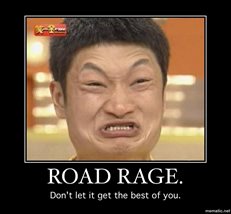There are countless example of road rage that leads to someone getting killed.
I ran across this story recently where two drivers in Michigan became angry at one another due to one's tailgating. They pulled over and shot and killed one another. One of the motorists even had family members in the car to witness this insanity.
"Here lies John Doe, killed because of tailgating".

How sad that will look on their tombstones.
It is my opinion that road rage is on the rise due to an increase in distracted drivers and heavier traffic. Think about all the distractions motorists and truck drivers have in their vehicles now: cell phone, texting, GPS, AM/FM radio, CB, satellite radio, various chargers, video cameras, bluetooth and tablets to name some. That doesn't even begin to factor the emotional state of a driver which contributes greatly to aggressive driving.
As professional drivers, we spend most of our time on the road where all the factors that contribute to road rage are alive and well each day. However, the keyword in that last sentence is
professional and we must always act as such. We have to let go of our anger because it's not worth getting hurt, killed or sued over. Below are some tips and other helpful information from the FMCSA website:
Did You Know ?
-
The most obvious form of road rage is aggressive and excessive speeding, particularly on congested highways or in bad weather.
-
Speed causes nearly one-third of all fatal motor vehicle crashes.
-
Speeding reduces the time drivers have to avoid a crash or a dangerous situation and greatly increases the likelihood the crash will be severe.
-
The energy released in a collision at 60 mph is 200 percent greater than at 40 mph, even though the speed has increased by only 50 percent.
Control Yourself
-
Wind down before you crank it up. Avoid making other drivers angry by avoiding anger yourself.
-
Anticipate situations and make plans accordingly. Regular traffic reports in most cities alert you to the traffic congestion. Learn alternate routes or leave for work earlier.
-
Take action before stress and fatigue get to you. Learn to spot warning signs and act on them.
-
If you plan a long journey, take it in stages. Do not remain behind the wheel for more than three hours without a break.
Be Patient & Pay Attention
-
Don't yell or use obscene gestures.
-
Don't block the passing lane. Stay to the right if you are obstructing the flow of traffic.
-
Always signal when changing lanes. Use your horn sparingly.
-
Don't tailgate.
-
Cooperate and don't compete on the road. Let other drivers merge into traffic in an orderly fashion.
-
Don't take another's actions personally. Everybody makes mistakes.
Avoid A Driving Assault
-
Don't react to another driver's uncivil behavior--avoid eye contact and don't tailgate, accelerate, brake or swerve suddenly, which can be seen as confrontational.
-
If confronted by an aggressive driver, go to the nearest police station if you continue to be hassled or think you are being followed.
-
Lock your doors.
-
When stopped in traffic, leave enough space to pull out from behind the car you are following.
-
Don't be tempted to start a fight or carry any sort of weapon. These acts may provoke an assault.